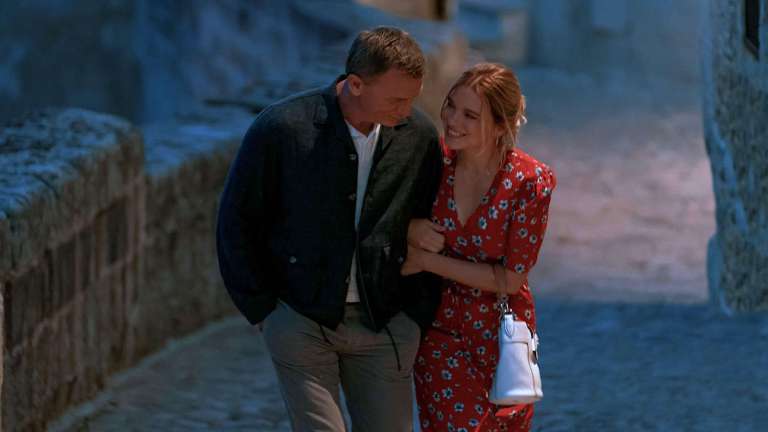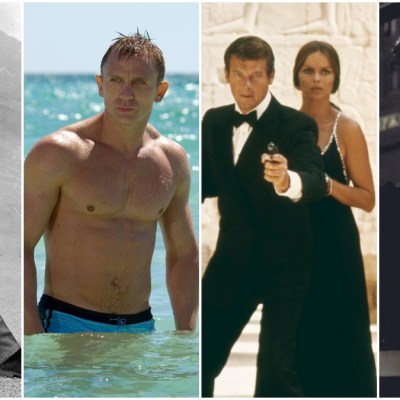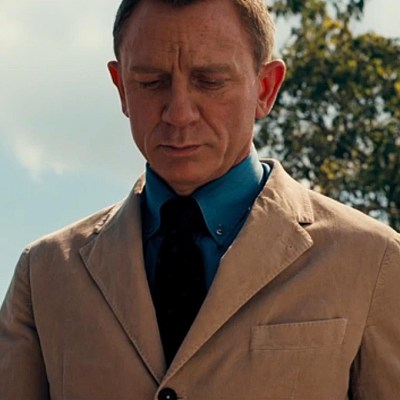How No Time to Die Fixes On Her Majesty’s Secret Service
No Time to Die intentionally reimagines one of James Bond’s most controversial adventures: On Her Majesty’s Secret Service.

This article contains major No Time to Die spoilers. Our spoiler-free review is here.
Shortly after George Lazenby attended a screening of No Time to Die last week, the Australian actor and one-time 007 jumped on Twitter to write, “I got to see the new Bond here in LA. Interesting choice of music, I must say.” Having seen the latest James Bond movie ourselves, it’s easy to guess why the star of On Her Majesty’s Secret Service (1969) would be so flattered with Daniel Craig’s swan song.
The influences of Lazenby’s OHMSS are unmistakable throughout No Time to Die, and in fact that connection has been speculated about ever since Spectre ended six years ago with Craig’s Bond retiring, driving off into the sunset with Madeleine Swann (Léa Seydoux). Like the ’69 movie before it, this coldhearted womanizer seemed to finally be settling down, and thawing that heart out. And yet, few could have guessed just how much No Time to Die would lean into those parallels.
Before we even hear Billie Eilish’s new Bond song, the new film’s extended pre-credits sequence includes an orchestral version of Louis Armstrong’s “All the Time in the World.” Hans Zimmer turns the most breezy Bond tune of all-time, which came from OHMSS, into a symphony of strings as we witness what happily ever after looks like for James Bond. He’s now in Matera, Italy with Madeleine, and they’re essentially honeymooning; the pair even quote the Armstrong song, just as Lazenby’s Bond did to the woman he married, Contessa Teresa di Vicenzo (Diana Rigg). Tracy Bond.
For longtime fans of the Bond franchise, this already puts No Time to Die on simultaneously nostalgic and tragic footing since any of them could tell you that Rigg’s Tracy is the one “Bond Girl” the original 007 loved… and the one who died in his arms. In that scene, Lazenby’s Bond even wept, “We have all the time in the world.” No Time to Die thus positions itself as the spiritual descendant or even remake of that film for the Daniel Craig era; a film about love and loss…
Still, even before NTD’s release that seemed dark. After all, hadn’t Craig’s 007 experienced enough tragedy following the loss of Eva Green’s Vesper Lynd in Casino Royale (2006)? Five movies later, she’s still hanging like a pall over his tenure. So I’m sure many fans wondered during No Time to Die whether history would repeat itself again. Would Craig’s final turn in the tuxedo end in the same heartache that took a little bit of the original version’s soul? As it turns out, no, not at all. Instead, No Time to Die is a revision of that ending—the film which fixes On Her Majesty’s Secret Service.
This is not to say it fixes it as a film. OHMSS finished near the top of our official ranking of Bond films, and is largely considered one of the most underrated entries in the franchise’s history. Christopher Nolan, among others, even lists it as his favorite Bond movie. But what makes No Time to Die’s homages remarkable is they address the older film in a way that brings resolution not only to Craig’s era, but also the ghosts of that ’69 movie which were left unresolved when producers Harry Saltzman and Cubby Broccoli elected to sweep that movie under the rug after it failed at the box office.
No Time to Die fixes On Her Majesty’s Secret Service for James Bond himself.
How No Time to Die Changes OHMSS’ Ending
This begins with the choice to separate James and Madeleine during their proverbial honeymoon without her receiving a bullet in the head like poor Tracy. Instead their separation is the tragic culmination of Bond’s own past traumas from Casino Royale onward. Madeleine knows that Vesper was “the big one,” to quote Christoph Waltz’s Blofeld. So she encouraged James in the opening to visit Vesper’s grave and put the pain to rest. Yet in sadly typical Bond movie fashion, Blofeld and SPECTRE anticipated Bond would one day return to Vesper’s tomb and hid a bomb there, as well as an apparently small army of idle assassins who must’ve spent years soaking in the Italian sun.
Bond survives their attack, of course, but he also hears a message from Blofeld designed to poison the well of his budding romance: Blofeld claims Madeleine is his creature who led Bond to slaughter. With a man as paranoid and oft-betrayed as 007, it’s enough to send his wounded chauvinism back to the forefront, and to convince him to leave Madeleine on the spot. Like Lazenby’s Bond, SPECTRE stole his happily ever after. Although unlike OHMSS, the woman he chose to settle down with is still breathing.
When Den of Geek’s Rosie Fletcher spoke with No Time to Die director Cary Joji Fukunaga, he told us about his relationship with OHMSS—as well as why he approached revisiting that story so differently.
“I watched [On Her Majesty’s Secret Service] and was impressed with the craft and scope of the film, and then also the storyline, and the fact that Bond got married and had this really poignant moment at the end of the film,” Fukunaga said. “That line, ‘We have all the time in the world.’”
And yet, the idea of “fridging” Madeleine—a modern term for the trope of killing female characters in order to heighten the pathos of male protagonists—seemed ghastly today.
Says Fukunaga, “When Barbara [Broccoli] and I were first talking about the project, and the fact that in Spectre Bond leaves with Léa Seydoux’s character, Madeleine Swann, there’s an expectation that something is going to happen. And there’s an expectation that something bad’s going to happen to her, specifically. ‘If there’s going to be a new film, there has to be a new Bond woman.’ And I remember Barbara saying, ‘We don’t want to do that. We don’t want to kill off someone simply to have a new flavor of the month in there.’”
So they didn’t. Instead, Bond’s greatest weakness—his general cynicism and misanthropy, especially toward women—is exploited by his enemy at the expense of his own happiness. This replicates the heartbreak of On Her Majesty’s Secret Service at the very beginning of the film, but unlike that or even Casino Royale—where a similar tragedy’s importance is squandered by a mediocre follow-up in Quantum of Solace (2008)—No Time to Die spends the rest of its running time satisfyingly exploring the fallout from Bond’s lifestyle and loss, and what could finally bring such a man lasting peace.
To be sure, we briefly get another classic Bond woman with a delightfully kooky performance by Ana de Armas as Paloma. With her plunging blue v-neck dress, worn quizzically in combat, she echoes the appearance of another beloved leading lady in the series, Barbara Bach’s Soviet agent in The Spy Who Loved Me (1977). Bach’s character was also the first to pick at the old wound of OHMSS by bringing up Tracy’s death to Bond. But they still have a frolicking romance, of course.
By contrast, de Armas’ Paloma, who is an anxious Cuban-American spy on her first mission, never gets romantic with Bond. Rather No Time to Die acknowledges how the scars of 007’s lifestyle, and losing now multiple loves to the game, can catch up with the character. He therefore comes off more as a bemused mentor to Paloma instead of a romantic foil.
Plus, he’s still hung up on Madeleine.
How No Time to Die Changes James Bond’s Ending
More than some world domination scheme, this is the true crux of No Time to Die. Unlike any other major Bond Girl before her, Dr. Swann is allowed to reenter James’ life. When she does, she quickly becomes the mission for Bond. He discovers evidence of his previous folly, and evidence of the life he gave up. He discovers Madeleine has given birth to a daughter whom he’s missed five years of happiness with.
By not “fridging” Madeleine, No Time to Die gets to ask fundamental questions no other movie dared: Who is James Bond… and who could he become? We’ve obviously never seen James as a father figure—or especially considered what it would mean for such a man to have a daughter. In this way, the man Bond is changes overnight. He goes from being a loner to at least trying to act the family man.
Which brings us to No Time to Die’s ending. The Bond franchise is still the Bond franchise. Invariably, the women James cares about, both Madeleine and now daughter Mathilde, wind up kidnapped by the new villain Safin (Rami Malek), who is a genocidal maniac. But saving the world is almost incidental to Craig’s Bond, a character for whom everything is always personal.
Hence the resolution to the movie, and Bond’s life. After he’s poisoned by Safin, James can still save himself. The nanobots in his blood are designed solely to kill Madeleine and Mathilde. But Bond himself is safe; he could continue on living, even returning to MI6 if he so chose—just without ever seeing the woman he loves or his daughter again. The lifestyle we’ve grown accustomed to watching 007 enjoy for 60 years is unthreatened. But the life he could’ve had with Tracy, with Vesper, and now with Madeleine? That has once again been cruelly stolen.
So rather than live on for another adventure, or in Craig’s case more self-loathing in a Jamaican hut, he accepts this as a good death. Or good enough. He walks up to the top of the villain’s lair and waits for the rockets he summoned to save the world. He dies alone, but with his death, he ensures Madeleine and Mathilde live on.
At the point in his life where he has everything to live for—a point which gives new meaning to the title “No Time to Die”—he accepts oblivion and gives mother and child all the time in the world.
This is Bond’s personal happy ending. If you asked Lazenby’s James if he’d rather Tracy or he be struck by Blofeld’s bullets in OHMSS, he’d probably offer himself up. He’d rather have died than watch Tracy be placed in “the refrigerator.” That’s also been demonstrably true of Craig’s Bond since Casino Royale; he never recovered from Vesper. At least now he has a chance for it to be him instead of her. More importantly, he has a daughter, a real Bond girl, whom he can protect.
It’s the ending Bond would’ve wanted in ‘69. So when No Time to Die finally fades to black, with Louis Armstrong’s “All the Time in the World” playing once more, Bond has gotten his long lost happy ending.
No Time to Die is playing in theaters now.


